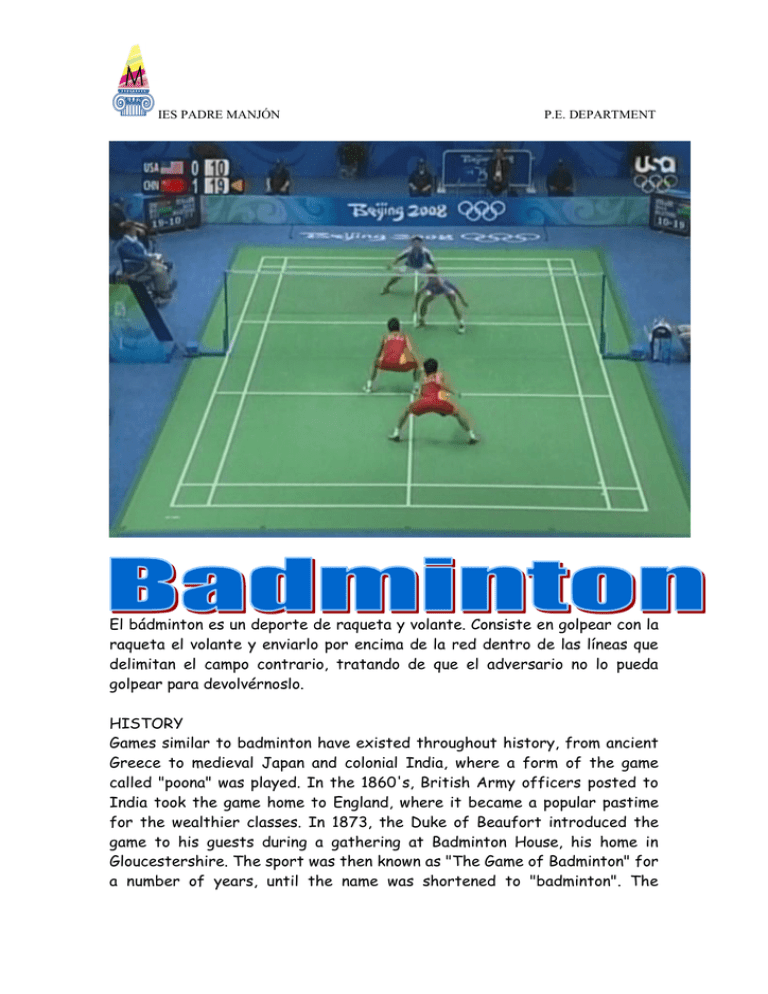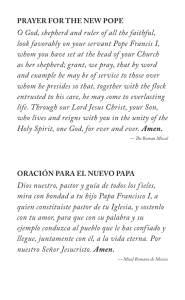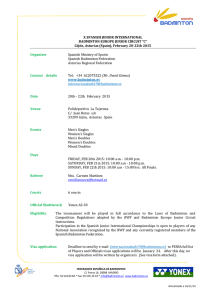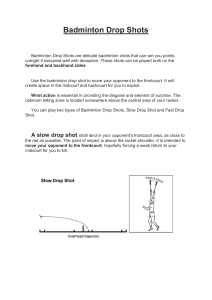El bádminton es un deporte de raqueta y volante. Consiste en
Anuncio

IES PADRE MANJÓN P.E. DEPARTMENT El bádminton es un deporte de raqueta y volante. Consiste en golpear con la raqueta el volante y enviarlo por encima de la red dentro de las líneas que delimitan el campo contrario, tratando de que el adversario no lo pueda golpear para devolvérnoslo. HISTORY Games similar to badminton have existed throughout history, from ancient Greece to medieval Japan and colonial India, where a form of the game called "poona" was played. In the 1860's, British Army officers posted to India took the game home to England, where it became a popular pastime for the wealthier classes. In 1873, the Duke of Beaufort introduced the game to his guests during a gathering at Badminton House, his home in Gloucestershire. The sport was then known as "The Game of Badminton" for a number of years, until the name was shortened to "badminton". The IES PADRE MANJÓN P.E. DEPARTMENT Badminton Association of England was formed in 1893 and soon after they published the first set of rules. In 1899 they organized the All England Open Badminton Championships, the world's first major badminton competition. The Badminton World Federation (BWF) was established in 1934, and since then the game has developed into a truly international sport, with top players now coming from Denmark, China, Indonesia, South Korea and Malaysia. Since 1992, badminton has also been an Olympic sport, with events for both men and women. THE GAME Badminton is played on a court marked for both singles and doubles matches. The doubles court is 6.1 metres wide and 13.4 metres long, and the singles court is a little smaller. The net is 1.55 metres high. To begin a singles game, players stand in diagonally opposite service courts (see diagram up) and the server then serves the shuttlecock underhand from below the waist. If the receiver thinks the serve is a fault, meaning it will land outside the receiver's service court, he or she can leave it and win the point if it does go out. But if the receiver thinks the serve is good, he or she must return it before it bounces. If the return is good, a rally begins. The rally continues until someone wins it by hitting a good shot which their opponent cannot return, or until someone loses it by IES PADRE MANJÓN P.E. DEPARTMENT hitting a fault. Whoever wins the rally earns one point, and serves to start the next point. FALTAS Son faltas: golpear el volante en el campo contrario si un jugador toca la red o los postes si se golpea dos veces seguidas en el mismo campo si el volante queda prendido en la red Son faltas de saque: sacar por encima de la cintura levantar un pie en el momento de recepcionar o realizar un servicio si los pies del que saca no están dentro de la zona de saque o está pisando una línea SHOTS Players can use a range of shots during a rally, including drop shots, drives, clears, smashes, kills, net shots and push shots. Top players learn to disguise their shots, and try to trick the opponent into thinking they're about to hit one type of shot, but then hit a very different type of shot, hoping to win the point by surprising the opponent. TIPOS DE GOLPES 1. Clear – Lob. Es un golpe de trayectoria alta, que va dirigido al fondo de la pista del adversario. Debes tener cuidado porque si te queda corto, el adversario te hará un remate. IES PADRE MANJÓN P.E. DEPARTMENT 2. Drop. Consiste en golpear el volante con suavidad de manera que quede “muerto” justo al pasar por encima de la red. 3. Smash. Es un golpe que va de arriba hacia abajo, dirigiendo el volante con fuerza hacia el suelo. Puede realizarse con salto. 4. Drive. Es un golpe lateral del volante que busca una trayectoria horizontal y cercana a la red, que obligue a una devolución defensiva del volante. 5. Golpe de Revés. Se golpea con el revés de la raqueta. El brazo de golpeo se sitúa por delante del cuerpo y extendiéndose a la altura del pecho para golpear. Se debe evitar en todo momento este tipo de golpeo durante el juego debido a su escasa eficacia. IES PADRE MANJÓN P.E. DEPARTMENT Los golpes al volante deben hacerse con movimientos bruscos de muñeca, coordinados con movimientos cortos y rápidos del brazo, para poder variar la velocidad y/o dirección del volante en el último momento antes de golpearlo. SCORING SYSTEM Play continues until one player wins the game by being the first to earn 21 points, with a margin of at least 2 points. For example, if the score is 21 to 19, the game is over. But if the score is 21 to 20, the game continues. If the player with 21 points then wins a point, the score is 22 to 20 and the game is over. Matches are usually the best of three games. This means that the first player to win two games wins the match. Before May 2006, players could only win a point on their own serve. But the scoring system was changed in 2006, and now players can earn a point on their own serve and also when their opponent serves. EL AGARRE DE LA RAQUETA El agarre de la raqueta. Para coger bien la raqueta se debe hacer esta sencilla operación: se coloca la empuñadura con el cordaje perpendicular al suelo. En esa posición se agarra la raqueta, colocando el pulgar entre el dedo índice y los demás. Esta es la llamada presa o agarre Universal. Se deben tener estas consideraciones: a) no coger la raqueta con los dedos juntos. b) cogerla firmemente, pero no demasiado apretada. c) debe ser una extensión del brazo. IES PADRE MANJÓN P.E. DEPARTMENT THE READY POSITION Being in the ready position allows players to move sharply in the direction that the shuttle is travelling. Try to: 1. 2. 3. 4. 5. 6. Place your feet shoulder-width apart Lean slightly forward Bend your knees Place your weight on the balls of your feet Hold your racket up in front of your body Keep your eyes on the shuttlecock EL SAQUE Para realizar un buen saque se debe adoptar la siguiente posición: 1. la raqueta la sostiene el brazo ejecutor estirado hacia atrás 2. la pierna contraria al brazo ejecutor ligeramente adelantada 3. el volante se sostiene por la base con el pulgar y el índice con el brazo extendido para que caiga adelantado Una vez que hemos adoptado esta posición damos paso al movimiento del saque: 4. se suelta el volante y se giran los hombros 5. se lleva la raqueta hacia delante para golpear el volante 6. el volante se golpea continuando el movimiento del brazo hacia arriba. La raqueta en el momento en que golpea al volante no debe sobrepasar la cintura. IES PADRE MANJÓN P.E. DEPARTMENT FAMOUS PLAYERS Peter Høeg Gade Peter Høeg Gade (right) was born in 1976 in Denmark. He is one of the most successful badminton players of recent times, leading the world rankings from 1998 to 2001. Fu Haifeng Fu Haifeng was born in Guangdong province in the People's Republic of China. He set the official world smash speed record on June 3, 2005. The shuttlecock's speed was measured at 332 km/h (approximately 206 mph), making badminton the fastest racket sport in the world. * Write the name of the badminton equipment: S__________ R_________ N___ IES PADRE MANJÓN B_____________ S________ P.E. DEPARTMENT R _____________ C _______ ASPECTOS A RECORDAR EN EL DESARROLLO DE LAS CLASES - No se cogen raquetas ni volantes hasta que no estén colocados los postes y redes/cintas - Sacaremos únicamente los volantes necesarios para que no estén tirados por ahí y se puedan pisar o perder. - Bajo ningún concepto se deben arrastrar las raquetas. Los cordajes también se rompen por eso - Si se nos rompe una cuerda no seguimos jugando con esa raqueta, la cambiamos e intentamos arreglarla después con mi ayuda. - Hay que tener cuidado no chocarnos con los compañeros que están jugando a nuestro lado. - Cuando juguemos a dobles nos comunicamos con nuestro compañero para ver quien golpea, así evitaremos raquetazos fortuitos. - Hay que moverse para golpear en condiciones favorables. - TODOS colaboramos organizadamente en la recogida del material: yo quito las gomas de los postes/cintas. Los postes pesan y no tienen que cargarlos siempre los mismos. Quien recoge postes da su raqueta a un compañer@ IES PADRE MANJÓN P.E. DEPARTMENT BADMINTON VOCABULARY Word Example sentence Meaning ace Jenny's accuracy means she serves lots of aces. a serve that the opponent fails to hit backcourt I ran to the backcourt to return his lob. back third of the court (same as "rearcourt") baseline The shuttlecock landed just inside the baseline. back line of the court bird / birdie The U.S. players say birdie instead of shuttlecock. shuttlecock (mostly used in North America) doubles Why don't you ask her to be your partner in mixed doubles? a game between teams of two players net The shuttlecock hit the top of the net and just went over, so she won the point. the length of meshed material supported on a cord between two posts that divides the court racket (also racquet) A badminton racket is smaller and lighter than a tennis racket. the instrument used by players to hit the shuttlecock serve In tennis players use overhead serves, but in badminton they use underarm serves. a shot which begins play rally The crowd applauded after watching another long, exciting rally. a series of shots hit back and forth across the net wood shot He was lucky when he hit a wood shot and the shuttlecock still went over the net. a legal shot in which the shuttlecock hits the frame of the racket Click the link for Badminton Vocabulary Exercises http://www.englishclub.com/vocabulary/sports-badminton.htm


